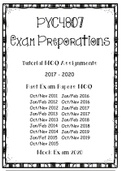PYC4807
Exam Preporations
Tutorial MCQ Assignments
2017 - 2020
Past Exam Papers MCQ
Oct/Nov 2011 Jan/Feb 2016
Jan/Feb 2012 Oct/Nov 2016
Oct/Nov 2012 Jan/Feb 2017
Jan/Feb 2013 Oct/Nov 2017
Oct/Nov 2013 Jan/Feb 2018
Jan/Feb 2014 Oct/Nov 2018
Oct/Nov 2014 Jan/Feb 2019
Jan/Fef 2015 Oct/Nov 2019
Oct/Nov 2015
Mock Exam 2020
, PYC4807/101/0/2017
14 APPENDIX A: ASSIGNMENTS
ASSIGNMENT 01
Multiple-choice assignment
Unique assignment number
576966
Closing date: 13 April 2017
In the article by Gadd and Phipps (2012), they refer to the challenges faced by psychological
and, specifically, neuropsychological assessment. Their study focused on a preliminary
standardisation of the Wisconsin Card Sorting Test (a non-verbal measure) for Setswana-
speaking university students. The US normative sample is described as participants (N = 899)
aged 18 to 29 years who were screened beforehand to exclude individuals with a history of
neurological, learning, emotional and attention difficulties. The South African sample consisted
of university students (N = 93) from both genders, between the ages of 18 and 29, who were
screened in terms of hearing and visual impairments and any history of psychiatric or
neurological difficulties. These students were from the University of Limpopo, Medunsa
Campus. Critically evaluate the South African normative sample by answering questions 1 and
2.
Question 1
There are similarities and differences between the South African and the original norm sample.
Given the purpose of the test, which characteristic(s) implies/imply that the local sample is
appropriate?
(1) age
(2) absence of hearing and visual impairments
(3) absence of psychiatric and neurological difficulties
(4) all of the above
Question 2
The South African normative sample is not representative of the broader South African
population aged 18 to 29 years in terms of …
(a) age
(b) gender
(c) educational level
(d) language
(1) (a) (b)
(2) (a) (c)
(3) (c) (d)
(4) (b) (d)
15
,Gradidge and De Jager (2011) evaluated the psychometric properties of the Wellness
Questionnaire for Higher Education. The Cronbach’s Alpha coefficients ranged between 0.80
and 0.96 for the seven subscales of the questionnaire and the test-retest coefficients ranged
between -0.04 and 0.71 for the seven subscales. Critically evaluate these findings by answering
questions 3 and 4.
Question 3
Which factors could have affected the test-retest coefficients?
(1) transfer effects such as practice and memory
(2) changes in the wellness construct over time
(3) error due to content sampling
(4) a lack of internal consistency
Question 4
The questionnaire will provide reliable indications of wellness levels among student populations.
(1) true, the measure is stable over time
(2) true, the measure is internally consistent
(3) false, the items are not related
(4) false, different constructs are measured
In the same study, Gradidge and De Jager (2011) reported that no practically significant
differences were found between the mean wellness of demographic groups (gender, language
or academic year level). This is in line with wellness theory and previous research. Factor
analysis also revealed the expected factor structure. Critically evaluate these findings by
answering questions 5 and 6.
Question 5
The statistical methods used here, were …
(a) correlations with other tests
(b) factorial validity
(c) convergent and discriminant validity
(d) theory-related group comparison
(e) incremental validity
(1) (a) (b)
(2) (a) (c)
(3) (b) (d)
(4) (d) (e)
16
, PYC4807/101/0/2017
Question 6
The theoretical model of wellness employed here is relevant for a multicultural South African
student population.
(1) true, the theoretical model was replicated across subgroups
(2) true, a new theoretical model was identified
(3) false, the underlying structure differed from the theoretical model
(4) false, the underlying structure differed between subgroups
Foxcroft (2004) provides guidelines for the development of a multicultural test. With regard to
the development of test content, she distinguishes between theory-based, empirical (criterion-
keying), and criterion-referenced (e.g. learning outcomes and job analysis) methods. Identify the
method as described in questions 7 to 8.
Question 7
The examination paper for the module in Psychological Assessment consists of questions
measuring the extent to which the student mastered the outcomes for this module. The content
domain was thus defined by means of the …
(1) theory-based approach
(2) empirical approach
(3) criterion-referenced approach
(4) normative approach
Question 8
The Senior South African Individual Scale – Revised (SSAIS-R) was based on the Wechsler
model of intelligence and the test consists of a variety of tasks that require intelligence. In
combination these tasks measure a general factor of intelligence consisting of two specific
factors, namely verbal and non-verbal intelligence. The content domain of the SSAIS-R was
thus defined by means of …
(1) a theoretical review
(2) contrasting groups
(3) an analysis of learning outcomes
(4) a job analysis
Question 9
In the case of criterion-referenced tests the content domain could be specified in terms of …
(a) a theoretical review
(b) contrasting groups
(c) an analysis of learning outcomes
(d) a job analysis
(1) (a) (b)
(2) (b) (c)
(3) (c) (d)
(4) (a) (c)
17





